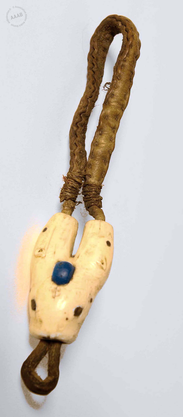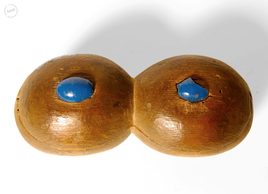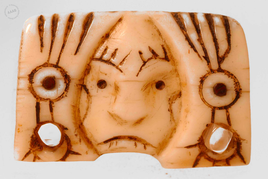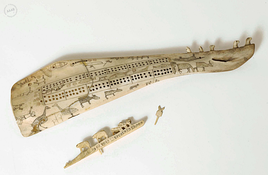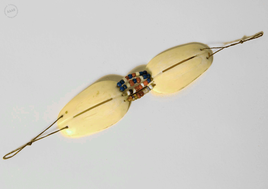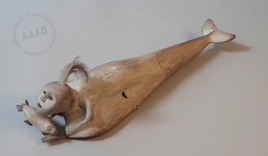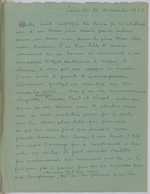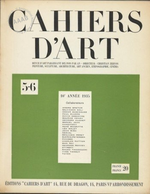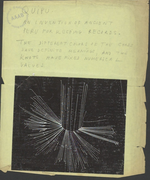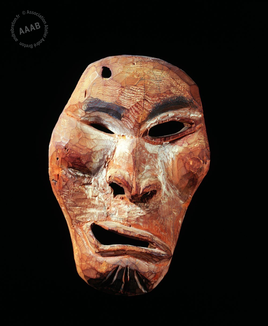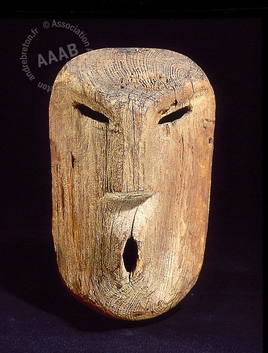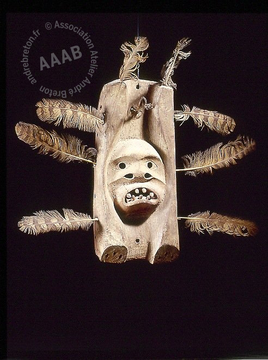Description
Objet inuit situé contre le mur de l'atelier.
Amulette gravée de deux têtes d'ours et d'une tête de phoque ou d'ours. En son milieu, on remarque une perle de verre de couleur bleue.
L'ivoire provient des dents de morse. Les Inuit le préparent et le travaillent d'abord avec des instruments de pierre, puis, à l'arrivée des Européens, avec des outils en fer ou en acier. [site André Breton, Marie Mauzé, 2014]
Expositions
- Présentation des collections permanentes : Paris, Musée national d'art moderne, depuis 2003.
- Big Bang [Présentation des collections permanentes] : Paris (France), Musée national d'art moderne, 02 mai 2005-28 février 2006.
- Présentation des collections permanentes (collections modernes) : Paris (France), Musée national d'art moderne, 01 février 2010-01 février 2012.
Bibliography
- Inuk, Inuit : art et tradition chez les Esquimaux d'hier et d'aujourd'hui [exposition] Arras, musée des Beaux-Arts, 12 décembre 1987 - 29 février 1988.
- Franz Boas, Eskimo Story (Written for my Children) : my Arctic Expedition, Connecticut, 2007.
| Creation date | sd |
| Languages | French |
| Physical description | Ivoire, verre, cuir.
20 x 3,7 cm |
| From / Provenance | sl |
| Place of origin |
|
| Museum | Musée national d'Art moderne, Centre Pompidou, Paris : AM 2003-3(45) |
| Method of acquisition and collection | Musée national d'Art moderne, Centre Pompidou, dation André Breton, 2003 |
| Copyright | cliché G. Meguerditchian/Centre Pompidou, MNAM-CCI |
| Reference | Dation_45 |
| Keywords | Indigenous peoples of the Americas, Wall, Ceremonial Art, Northern People, Sculpture |
| Categories | Native Americans, British Columbia |
| Permanent link | https://cms.andrebreton.fr/en/work/56600100172680 |
Place of origin

Description
Catalogue édité à l'occasion d'une vente aux enchères à l'hôtel Drouot les 23 et 24 janvier 1930.
Alaska, Mexique, Costa Rica, Colombie, Pérou, Venezuela, Bolivie : pierres sculptées, poteries, étoffes, bronzes.
Afrique: Congo, Belge, Soudan, Guinée, Côte d'Ivoire, Dahomey : masques et fétiches.
Océanie: belle suite de tapaz (Étoffes décoratives) bois sculptés,
Asie : Sumatra, Java, Indes : bois sculptés, etc.
Dont la vente aux enchères publiques aura lieu Hôtel Drouot, Salle n° 10, les jeudi 23 et vendredi 24 janvier 1930, à deux heures. Me Léon Flagel, commissaire-priseur ; M. André Portier, expert, chez lesquels se trouve le présent catalogue. [catalogue de la vente, 2003]
| Bibliographical material | Paris, Imprimerie Lahure, 1929. |
| Date of publication | 1930 |
| Publication | first publication |
| Languages | French |
| Size | 20,00 x 28,00 cm |
| Number of pages | 21 p. |
| Publisher | Hôtel Drouot, Paris |
| Reference | 4957000 |
| Breton Auction, 2003 | Lot 6067 |
| Keywords | Pre-Columbian Art, Mexico, Ceremonial Art, Oceania, Northern People, auction sales |
| Categories | Catalogues, books on art, artist's books |
| Set | Sales order catalogue |
| Exhibition | Art primitif, 1930
|
| Permanent link | https://cms.andrebreton.fr/en/work/56600100025260 |
Exhibition place

Description
Catalogue édité à l'occasion d'une vente aux enchères publiques à l'Hôtel Drouot les 25 et 26 octobre 1928.
« Poteries, pierres sculptées, objets divers. Art africain ; statuettes, masques et fétiches, poteries, etc. Dont la vente aux enchères publiques aura lieu Hôtel Drouot, Salle n° 10, les jeudi 25 et vendredi 26 octobre 1928, à deux heures / Me Léon Flagel, commissaire-priseur ; M. André Portier, expert. » [catalogue de la vente, 2003]
| Bibliographical material | Paris, Imprimerie Lahure, 1928. |
| Date of publication | 1928 |
| Publication | first publication |
| Languages | French |
| Size | 20,00 x 28,00 x 1,00 cm |
| Number of pages | 16 p. |
| Publisher | Hôtel Drouot, Paris |
| Reference | 4952000 |
| Breton Auction, 2003 | Lot 6067 |
| Keywords | Pre-Columbian Art, Ceremonial Art, Northern People, auction sales |
| Categories | Catalogues, books on art, artist's books |
| Set | Sales order catalogue |
| Exhibition | Arts de l'Amérique précolombienne, 1928
|
| Permanent link | https://cms.andrebreton.fr/en/work/56600100054320 |
Exhibition place

Description
Bâton cérémoniel sculpté sur trois registres successifs. Au sommet, un personnage se tenant debout, les yeux et la bouche de grandes dimensions, les mains reposant sur la poitrine. Le soutenant, un oiseau au long bec, le plumage traité en un long manteau. Plus bas, un personnage tenant dans la bouche un poisson, sans doute un saumon, reposant verticalement sur son torse. Comme pour le premier personnage, seules les jambes émergent de l'ensemble, dessinant ici une double fourche.
Bibliography
- Alain Jouffroy, « La collection André Breton », L'Œil, n° 10, octobre 1955, rep. p. 35
- Paris, Musée National d'Art Moderne/Centre Georges Pompidou, André Breton, La beauté convulsive, 1991, rep. p. 79, (photo Sabine Weiss, 1960, dans l'atelier avec Aube.)
Place of origin

Description
Objet inuit placé contre le mur de l'atelier.
Phoque stylisé et crochet taillés dans de l'ivoire de morse. Objets collectés en 1869 dans la baie de Liverpool.
Les deux objets sont respectivement attachés au bout d'un tendon et d'une cordelette tissée de perles de verre. [notice de 2003]
| Creation date | 1865 |
| Languages | French |
| Physical description | Ivoire, pâte de verre, tendon.
Hauteur avec les attaches : 23,5 cm |
| From / Provenance | sl |
| Place of origin |
|
| Museum | Musée national d'Art moderne, Centre Pompidou, Paris : AM 2003-3(49) |
| Method of acquisition and collection | Musée national d'Art moderne, Centre Pompidou, dation André Breton, 2003 |
| Size | 23,50 x 10,00 x 1,50 cm |
| Copyright | G. Meguerditchian/Centre Pompidou, MNAM-CCI |
| Reference | Dation_49 |
| Keywords | organic items, Wall, Ceremonial Art, Northern People |
| Categories | Inuit Yup'ik Art |
| Permanent link | https://cms.andrebreton.fr/en/work/56600100322280 |
Boîte esquimau (toutaïs)
Nouvelle-Écosse, baie de Liverpool
Various Objects
Description
Boîte esquimau placée le long du mur de l'atelier.
Boîte en bois en forme de lunette avec deux pierres bleues en leur centre. À l'intérieur deux os hémisphériques avec pierre bleue en pâte de verre. Étiquette manuscrite à l'intérieur du couvercle indiquant l'origine.
| Creation date | sd |
| Languages | French |
| Physical description | Bois, os, turquoise (?), pâte de verre.
15,4 x 6 x 6,5 cm |
| From / Provenance | sl |
| Place of origin |
|
| Museum | Musée national d'Art moderne, Centre Pompidou, Paris : AM 2003-3(44) |
| Method of acquisition and collection | Musée national d'Art moderne, Centre Pompidou, dation André Breton, 2003 |
| Copyright | © G. Meguerditchian/Centre Pompidou, MNAM-CCI |
| Reference | Dation_44 |
| Keywords | Wall, Ceremonial Art, Northern People |
| Categories | Inuit Yup'ik Art |
| Permanent link | https://cms.andrebreton.fr/en/work/56600100088950 |
Description
Amulette ou pendentif placé le long du mur de l'atelier d'André Breton (côte nord-ouest, Tlingit?).
Cet objet en ivoire gravé représente un épaulard. Sa grande nageoire dorsale comporte dans la partie haute, une perle encadrée de deux incisions horizontales, sous lesquelles un oeil, une narine, une bouche se découpent. Dans le registre inférieur, le visage de profil d'une figure humaine est gravé.
Est gravé un second visage sur les nageoires situées à l'arrière de la mâchoire. Les gravures en S sur le corps de l'animal représentent la cage thoracique du cétacé. Cet objet est probablement un pendentif ou une amulette. [site André Breton, Marie Mauzé, 2014-2015]
Expositions
- Présentation des collections permanentes : Paris, Musée national d'art moderne, depuis 2003.
- Big Bang [Présentation des collections permanentes] : Paris (France), Musée national d'art moderne, 02 mai 2005-28 février 2006.
- Présentation des collections permanentes (collections modernes) : Paris (France), Musée national d'art moderne, 01 février 2010-01 février 2012.
Bibliography
- Allen Wardwell, Yakutat South Indian Art of the Northwest Coast, The Art Institute of Chicago, 1964.
- Paris, Musée national d'Art moderne/Centre Georges Pompidou, André Breton, La Beauté convulsive, 1991, p. 80.
| Creation date | circa 1800 |
| Languages | French |
| Physical description | Ivoire |
| From / Provenance | sl |
| Place of origin |
|
| Museum | Musée national d'Art moderne, Centre Pompidou, Paris : AM 2003-3(51) |
| Method of acquisition and collection | Musée national d'Art moderne, Centre Pompidou, dation André Breton, 2003 |
| Size | 7,00 x 8,00 x 1,00 cm |
| Copyright | cliché G. Meguerditchian/Centre Pompidou, MNAM-CCI |
| Reference | Dation_51 |
| Keywords | Indigenous peoples of the Americas, Graphic Arts, organic items, Wall, Ceremonial Art, Northern People, Sculpture |
| Categories | Native Americans, British Columbia |
| Permanent link | https://cms.andrebreton.fr/en/work/56600100125380 |
Place of origin

Description
Élément de parure (inuit ?) en ivoire placé le long du mur de l'atelier.
| Creation date | sd (début XXe) |
| Languages | French |
| Physical description | Ivoire |
| From / Provenance | sl |
| Place of origin |
|
| Museum | Musée national d'Art moderne, Centre Pompidou, Paris : AM 2003-3(39) |
| Method of acquisition and collection | Musée national d'Art moderne, Centre Pompidou, dation André Breton, 2003 |
| Size | 3,40 x 2,20 x 0,30 cm |
| Copyright | cliché G. Meguerditchian/Centre Pompidou, MNAM-CCI |
| Reference | Dation_39 |
| Keywords | organic items, Wall, Ceremonial Art, Northern People, Sculpture |
| Categories | Native Americans, British Columbia |
| Permanent link | https://cms.andrebreton.fr/en/work/56600100979580 |
Place of origin

1 Comment
| |
|---|
L'objet est bien inuit : il pourrait s'agir d'une attache de ceinture.
William W. Fitzhugh et Susan A. Kapan reproduisent une pièce très semblable dans Inua, Spirit World of the Bering Sea (1982, p.148 - objet rapporté par Edward W. Nelson d'Alaska).
Description
Ouvrage sur les sculptures des peuples d'Arctique édité à Copenhague en 1959.
| Creation date | 1959 |
| Bibliographical material | Copenhague, Schultz Forlag, 1959. |
| Date of publication | 1959 |
| Publication | first publication |
| Languages | French |
| Size | 18,00 x 24,00 x 1,00 cm |
| Number of pages | 46 |
| Breton Auction, 2003 | Lot 6031 |
| Keywords | Ceremonial Art, Northern People, Sculpture |
| Categories | Catalogues, books on art, artist's books |
| Permanent link | https://cms.andrebreton.fr/en/work/56600100964330 |
Description
Dent de morse gravée placée le long du mur de l'atelier.
Dent de morse sur laquelle est gravée à chacune des extrémités une tête de cétacé, probablement un épaulard, avec au centre un visage humain. Cet objet a certainement été fabriqué pour la vente. Le graphisme est plutôt maladroit. [site André Breton, Marie Mauzé, 2014]
Expositions
- Présentation des collections permanentes : Paris, Musée national d'art moderne, depuis 2003.
- Big Bang [Présentation des collections permanentes] : Paris (France), Musée national d'art moderne, 02 mai 2005-28 février 2006.
- Présentation des collections permanentes (collections modernes) : Paris (France), Musée national d'art moderne, 01 février 2010-01 février 2012.
| Creation date | 1910 - 1920 |
| Languages | French |
| Physical description | Ivoire. |
| From / Provenance | sl |
| Place of origin |
|
| Museum | Musée national d'Art moderne, Centre Pompidou, Paris : AM 2003-3(52) |
| Method of acquisition and collection | Musée national d'Art moderne, Centre Pompidou, dation André Breton, 2003 |
| Size | 3,20 x 18,20 x 6,00 cm |
| Copyright | G. Meguerditchian/Centre Pompidou, MNAM-CCI |
| Reference | Dation_52 |
| Keywords | Indigenous peoples of the Americas, organic items, Wall, Ceremonial Art, Northern People |
| Categories | Native Americans, British Columbia |
| Permanent link | https://cms.andrebreton.fr/en/work/56600100551030 |
Place of origin

Description
Jeu placé le long du mur de l'atelier.
Mâchoire gravée de scènes animalières et damiers de jeu. Les dents ont été retaillées en forme de têtes de phoque. [Notice de 2003]
| Creation date | sd |
| Languages | French |
| Physical description | Ivoire et os |
| From / Provenance | sl |
| Place of origin |
|
| Museum | Musée national d'Art moderne, Centre Pompidou, Paris : AM 2003-3(46) |
| Method of acquisition and collection | Musée national d'Art moderne, Centre Pompidou, dation André Breton, 2003 |
| Size | 8,50 x 32,50 x 3,00 cm |
| Copyright | G. Meguerditchian/Centre Pompidou, MNAM-CCI |
| Reference | Dation_46 |
| Keywords | organic items, Wall, Ceremonial Art, Decorative Art, Northern People |
| Categories | Inuit Yup'ik Art |
| Permanent link | https://cms.andrebreton.fr/en/work/56600100428700 |
1 Comment
| |
|---|
On peut ajouter que ce type de pièces était destiné aux voyageurs occidentaux.
L'art chez les peuples primitifs
Afrique, Océanie, Archipel malais, Amérique et Terres arctiques; styles et civilisations
Book
Author
Author Adolphe Basler
Description
Ouvrage d'Adolfe Basler publié à Paris en 1929. [catalogue de la vente, 2003]
83 pages et 105 planches illustrées.
| Bibliographical material | Paris, Librairie de France, 1929. |
| Date of publication | 1929 |
| Publication | first publication |
| Languages | French |
| Size | 20,00 x 27,00 cm |
| Number of pages | 83 |
| Publisher | Librairie de France, Paris |
| Reference | 4823000 |
| Breton Auction, 2003 | Lot 6011 |
| Keywords | Arizona, Monographs, Ceremonial Art, Oceania, Northern People |
| Categories | Catalogues, books on art, artist's books |
| Permanent link | https://cms.andrebreton.fr/en/work/56600100801910 |
Description
Lunettes inuit placées le long du mur de l'atelier.
Deux coques en ivoire avec fente horizontale, réunies par quatre rangs de perles de verre enfilées sur des boyaux. Ces derniers sont noués aux extrémités afin de pouvoir passer les oreilles dans les boucles aménagées à cet effet.
La cécité des neiges est une maladie douloureuse et handicapante due à l'excès de rayons ultraviolets, résultant généralement du puissant éblouissement provoqué par l'association de la glace atmosphérique et de la lumière vive par beau temps. Les lunettes de neige avec leurs fines incisions horizontales pour les yeux laissaient un ample champ de vision. Parallèlement, l'étroitesse des fentes pour les yeux et le débordement au-dessus des arcades sourcilières atténuaient l'éblouissement. Ces lunettes étaient généralement portées d'avril à septembre. Avant le XVIIIe siècle, elles étaient principalement en ivoire, mais la plupart des exemples du XIXe siècle sont en bois. Les lunettes de neige traditionnelles, comme celles-ci, ont aujourd'hui cédé la place aux lunettes de soleil. [Marie Mauzé, site André Breton, 2014].
Expositions
. - Présentation des collections permanentes: Paris, Centre Pompidou depuis 2003.
- Big Bang [Présentation des collections permanentes]: Paris, Centre Pompidou. 2 mai 2005 - 28 février 2006.
Bibliography
- Inuk : art et traditrions chez les Esquimaux d'hier et d'aujourd'hui [exposition] Arras, musée des Beaux-Arts, 12 décembre 1987-29 février 1988.
- Totems & Shamans. Arts anciens d'Alaska et de Colombie britannique, Paris, galerie Flak, 2008.
| Creation date | circa 1800 |
| Languages | French |
| Physical description | ivoire, pâte de verre, boyau |
| From / Provenance | sl |
| Place of origin |
|
| Museum | Musée national d'Art moderne, Centre Pompidou, Paris : AM 2003-3(48) |
| Method of acquisition and collection | Musée national d'Art moderne, Centre Pompidou, dation André Breton, 2003 |
| Size | 4,00 x 13,00 x 1,50 cm |
| Copyright | cliché G. Meguerditchian/Centre Pompidou, MNAM-CCI |
| Reference | Dation_48 |
| Keywords | organic items, Wall, Ceremonial Art, Decorative Art, Northern People |
| Categories | Native Americans, British Columbia |
| Permanent link | https://cms.andrebreton.fr/en/work/56600100774150 |
Place of origin

Description
Probably of Yup'ik origin, this mask is from the beginning of the 20th century and represents a whale-person. It was acquired by Breton in 1935.
This sculpted mask, from the early twentieth century represents a whale, or more precisely, a "whale-person." Indeed, the Yupiit (Alaska) considered these animals as subjects endowed with human qualities. The mask is formed in the shape of a whale, and elongates towards a human head with finely sculpted features, adorned by a tuft of feathers. The small orifice located at the top of the head from which the feathers appear represents the blowhole of the marine mammal, and the feathers represent the spouting of water being ejected. Underneath the head, at the level of the shoulders, are two arms which transform into fins, upon which rest a seal. The head comprises a human face which is stylized and sculpted in bas-relief, representing the yua, the soul of the animal, or literally "its self." By combining the zoomorphic elements and the anthropomorphic elements—generally a human face representing the interiority of this animal— the Yupiit created images of "animal people," whose features characterized a specific species and therefore permitted identification of the animal represented.
This mask was exchanged by André Breton along with another object during the July 1935 exposition at the Charles Ratton gallery, "Exhibition of masks and ancient ivories from Alaska and the North-West American coast." However, it was in between 1942-1946, while the surrealists were exiled in New York, that Breton and his friends were able to procure important collections of Yup'ik and Amerindian art (from the North-West and South-West coasts). Breton, Robert Lebel, Roberta Matta, Enrico Donati, Isabelle Waldberg and Dolores Vanetti were particularly interested in the Yup'ik art from Kuskokwim and the lower Yukon area. Lebel sketched the masks that he and his friends purchased as well as others, inspired from images published in ethnographic works, such as the famous The Eskimo about the Bering Strait by Edward William Nelson. In Lebel's notebook (conserved in the Museum of Quai Branly), Lebel sketched a mask that he noted belonged to Dolores Vanetti.
The superb collection of Breton contains seven masks from the region of Kuskokwim and the lower Yukon area (see the photograph of his apartment-atelier in Paris taken by Sabine Weiss in June of 1956) which he purchased from George Heye, the founder of the Museum of the American Indian, through the intermediary, Julius Carlebach. From the 1920s on, George Heye, who found himself in serious financial difficulty, decided to sell or exchange objects that he considered (erroneously) as "doubles." Yup'ik masks were often made in pairs, but one was always complementary or symmetrical to the other – never were they completely identical. This was how the Museum of the American Indian, who possessed the most important collection of Yup'ik masks in the world, ceded around sixty of them to Carlebach in the 1940s – to the delight of collectors such as the surrealists.
The surrealists were conquered by the power of suggestion that these objects were intimately associated with dreams and visions, and with their great formal liberty. The masks appeared in the shaman's dreams, and then were built by artists under the shaman's supervision. They were made of heterogeneous materials such as wood, feathers, hair. The masks were used in the ceremonial house at the end of winter during the proprietary rituals in which the community participated to invoke certain animals (whales, seals, caribous, etc.) in order to put their bodies at the disposition of humans during the next hunting season. The Yup'ik needed these animals for food and to survive in the hostile environment they lived in. Worn by the dancers, or hung on the walls of the ceremonial house, the masks represented the "souls" of the animals and the auxiliary spirits of the shamans. Their apparition was accompanied by stories that retraced certain aspects of a mythology, and by rhythmic songs percussed by tambourines. These masks were originally ephemeral creations: destined to be destroyed by fire or abandoned in the tundra after being the vessel of a ceremonial power.
[Marie Mauzé, André Breton website, 2014]
Exhibition
Cahors, Musée de Cahors Henri-Martin, La Maison de verre, André Breton, initiateur découvreur, 20 septembre - 29 décembre 2014 (exhibition prolonged until the 1st of February 2015)
Bibliography
- Paul Éluard, « La nuit est à une dimension », Cahiers d'Art, n° 5-6, 10e année, 1935, p. 99-100, rep. p. 100.
- Musée de Cahors Henri-Martin, La Maison de verre André Breton initiateur découvreur, Paris, Éditions de l'Amateur, 2014, rep. p. 93, 94, cité p. 92-94
- Marie Mauzé, "The Yup'ik World And The Surrealists", in Donald Ellis (dir.), Art Of The Arctic: Reflections Of The Unseen, with essays by Dawn Ades, Colin Browne and Marie Mauzé, London, Black Dog Publishing, 2015, p. 54-61 , rep. p. 57, notes p. 152.
Places of origin

See also
3 Works
| |
|---|
False
Would you like to record this work in your own portfolio ? In this portfolio, it is easy to get your own images galllery for you or your students. You may collect every description you need for a work in progress. You may as well imagine your ideal gallery, or a virtual exhibition.
To create your portfolio, you need to create an account, clicking on ID. You may create your new portfolio under the Menu Participate, selecting Portfolios. Once the page opened, in the left margin, under the section « Portfolios », please select « Add a portfolio ».
False
Would you like to record this work in your own portfolio ? In this portfolio, it is easy to get your own images galllery for you or your students. You may collect every description you need for a work in progress. You may as well imagine your ideal gallery, or a virtual exhibition.
To create your portfolio, you need to create an account, clicking on ID. You may create your new portfolio under the Menu Participate, selecting Portfolios. Once the page opened, in the left margin, under the section « Portfolios », please select « Add a portfolio ».
False
Would you like to record this work in your own portfolio ? In this portfolio, it is easy to get your own images galllery for you or your students. You may collect every description you need for a work in progress. You may as well imagine your ideal gallery, or a virtual exhibition.
To create your portfolio, you need to create an account, clicking on ID. You may create your new portfolio under the Menu Participate, selecting Portfolios. Once the page opened, in the left margin, under the section « Portfolios », please select « Add a portfolio ».
-
Numéro 5 - 6, de la dixième année 1935, de cette revue artistique et littéraire éditée par Christian Zervos à Paris.
Une image, une notice descriptive.
[Journal] Cahiers d'art
1 Comment
| |
|---|
L'analyse de l'exposition de 1935 chez Charles Ratton et des inventaires envoyés par George Heye au marchand donne tout à fait raison à Marie Mauzé : le masque a effectivement été acquis à Paris en 1935 ou en 1936 (Elizabeth Cowling indique que Breton a justement acquis un masque inuit un an après l'exposition, se fondant certainement sur les souvenirs de Robert Lebel).
Le masque qui apparaît dans le carnet de Robert Lebel et qui a été acheté par Dolores Vanetti était probablement son jumeau.
Description
Yup'ik Mask, dated from the begininning of the 20th century, in polychrome wood and feathers, presently conserved at the Museum of Quai Branly.
| Creation date | circa 1900 |
| Languages | French |
| Physical description | Bois polychrome, plumes |
| From / Provenance | Heye Foundation |
| Museum | Musée du Quai Branly, Paris : 70.1999.1.1.1-3 |
| Method of acquisition and collection | Musée du Quai Branly, don Aube et Oona Elléouët, 2003 |
| Size | 84,00 x 60,00 x 57,00 cm |
| Keywords | Mask, organic items, Ceremonial Art, Northern People, Sculpture |
| Categories | Native Americans, Etnographical Art, Inuit Yup'ik Art |
| Set | [Photos d'objets] photos in the studio |
| Permanent link | https://cms.andrebreton.fr/en/work/56600100424230 |
See also
2 Works
| |
|---|
False
Would you like to record this work in your own portfolio ? In this portfolio, it is easy to get your own images galllery for you or your students. You may collect every description you need for a work in progress. You may as well imagine your ideal gallery, or a virtual exhibition.
To create your portfolio, you need to create an account, clicking on ID. You may create your new portfolio under the Menu Participate, selecting Portfolios. Once the page opened, in the left margin, under the section « Portfolios », please select « Add a portfolio ».
-
Deux albums de photographies d'objets d'Amérique du Nord et d'Océanie, annotées par André Breton.
121 images, une courte notice descriptive, des liens.
[Photos d'objets] photos in the studio
False
Would you like to record this work in your own portfolio ? In this portfolio, it is easy to get your own images galllery for you or your students. You may collect every description you need for a work in progress. You may as well imagine your ideal gallery, or a virtual exhibition.
To create your portfolio, you need to create an account, clicking on ID. You may create your new portfolio under the Menu Participate, selecting Portfolios. Once the page opened, in the left margin, under the section « Portfolios », please select « Add a portfolio ».
Description
Yup'ik Ceremonial Mask from Alaska, dated from the beginning of the 20th century.
"The Yup'ik people from the region of Yukon-Kuskokwim lived primarily from fishing and hunting marine mammals.
"The large villages included one or more communal houses in which men lived and worked. It was there that they sculpted masks, often under the supervision of a shaman. It was also where festive gatherings and propitiatory ceremonies took place, in which the whole community would participate. During these festivities, the masked dancers re-enacted events from mythological tales, often performing moralizing fables or miming comic scenes.
"The Fish Mask belongs to this type of ritual. This mask is one of an identical pair - the other conserved at the Museum of the American Indian. The human face is not the principal representation on the mask; what is most important is the fish. The fish, with its head at the base, allows for a half-face to appear above, which is probably its yua (soul). Within the Yup'ik culture, the souls of animals are always represented with human features. It was the soul of the fish that would decide whether or not to give its body to that of man. His example then would be followed by other fish: the yua thus determines a period of abundance or famine for the community. The grimacing mouth on the mask reflects the ambivalence of the decisive moment of the life of this fish: the animal gives itself, but at the same time is destroyed by the man who eats it. The menacing mouth also denotes the observation of natural laws by the fish; it forewarns the man that the observance of taboos and rules concerning fishing must be respected. If these laws are not respected, the animal world will not forgive man. This sculpture, with its half-animal, half-human personality, evokes an important duality at the heart of Yup'ik beliefs." (Notice from the Museum of Quai Branly, Pavillon of Sessions, Museum of the Louvre)
Bibliography
- Germain Viatte, Tu fais peur tu émerveilles, Musée du Quai-Branly, acquisitions 1998/2005, Musée du Quai-Branly/Réunion des Musées nationaux, Paris, 2006, rep. p.45, fig. 15.
See also
2 Works
| |
|---|
False
Would you like to record this work in your own portfolio ? In this portfolio, it is easy to get your own images galllery for you or your students. You may collect every description you need for a work in progress. You may as well imagine your ideal gallery, or a virtual exhibition.
To create your portfolio, you need to create an account, clicking on ID. You may create your new portfolio under the Menu Participate, selecting Portfolios. Once the page opened, in the left margin, under the section « Portfolios », please select « Add a portfolio ».
-
Deux albums de photographies d'objets d'Amérique du Nord et d'Océanie, annotées par André Breton.
121 images, une courte notice descriptive, des liens.
[Photos d'objets] photos in the studio
False
Would you like to record this work in your own portfolio ? In this portfolio, it is easy to get your own images galllery for you or your students. You may collect every description you need for a work in progress. You may as well imagine your ideal gallery, or a virtual exhibition.
To create your portfolio, you need to create an account, clicking on ID. You may create your new portfolio under the Menu Participate, selecting Portfolios. Once the page opened, in the left margin, under the section « Portfolios », please select « Add a portfolio ».
Description
Yup'ik mask from Alaska in wood, partially painted with white and black pigments, not dated, acquired by André Breton in New York in 1945.
This mask represents a human face, the high cheek bones under asymmetrical open eyes, the mouth grimacing. Traces of scabbling are visible under the surface of the mask. White and black pigments highlight the eyelids and the nose.
Inside the mask, two stamps from customs. [Auction catalogue, 2003]
Places of origin

Description
Mask representing a human face pigmented in two colors, the top part is a yellow ochre and the details of the face are colored in red.
Created with the utmost artistry, this mask represents a human face, in striking realism. Pigmented in two colors, the top part is a yellow ochre while the details of the face are colored in red. The eyes and the nostrils are almond-shaped, and are created of circular perforations in the wood. The open mouth is in the form of a crescent, with the points turning downward. The lips are drawn, encircling this shape. At the back of the mask there is a double hoop in wicker, on which eight white feathers rest, bordering the face of the mask.
According to the archives at the Heye Foundation, this little mask represents Akasta, the sun, and is originally from the region of Bethel, on the south side of the Kuskokwim river. The beautiful quality of the sculpture, as well as the exceptional artistry that this mask holds, is an exquisite account of the Kuskokwim culture. [Auction catalogue, 2003]
Bibliography
- Paris, Musée National d'Art Moderne/Centre Georges Pompidou, André Breton, La beauté convulsive, 1991, rep. p. 375 (photo Sabine Weiss, 1956, dans l'atelier)
- William Rubin, Primitivism in XXth century art - Affinity of the Tribal and the Modern, New York, The Museum of Modern Art, 1984, rep. p. 578
- Alain Jouffroy, « La collection André Breton », L'œil, n° 10, octobre 1955, rep. p. 34
| Languages | French |
| Physical description | Bois tendre, polychromie rouge et blanche, plumes, fibres végétales, patine d'usage |
| From / Provenance | Ancienne collection A. H. Twitchell, Heye Foundation n° d'inventaire 09/3411, échangé avec Julius Carlebach le 10 mars 1945. |
| Place of origin |
|
| Size | 26,70 x 29,20 x 3,80 cm |
| Breton Auction, 2003 | Lot 6171 |
| Keywords | Mask, organic items, Ceremonial Art, Northern People |
| Categories | Native Americans, Etnographical Art, Inuit Yup'ik Art |
| Exhibition | Moon Dancers : Yup'ik Masks and the Surrealists
|
| Permanent link | https://cms.andrebreton.fr/en/work/56600100396920 |
Place of origin

Description
Yup'ik mask from Point Hope, Alaska, that André Breton acquired in July of 1944 in New York.
This mask represents a human face, roughly sculpted, with slits for eyes. The knotty curvature of the wood accentuates the vertical form of the mouth. Two holes were made in the mask (one of the left temple, the other on the right cheek) no doubt for holding the mask up to the face of a performer. Beautiful work. (Cf. Dorothy Jean Ray, Eskimo Masks-art and Ceremony, Seattle, London, University of Washington Press, 1967, fig. 32) [Auction catalogue, 2003]
Bibliography
Cf. Dorothy Jean Ray, Eskimo Masks-Art and Ceremony, Seattle, Londres, University of Washington Press, 1967, fig. 32
Alain Jouffroy, « La collection André Breton », L'Œil, n° 10, octobre 1955, rep. p. 34
William Rubin, Primitivism in XXth century art - Affinity of the Tribal and the Modern, New York, The Museum of Modern Art, 1984, rep. p. 578
Paris, Musée National d'Art Moderne/Centre Georges Pompidou, André Breton, La beauté convulsive, 1991, rep. p. 76 (photo Sabine Weiss, 1960, dans l'atelier) ; rep.p. 375 (photo Sabine Weiss, 1956, dans l'atelier).
Manipuler l'objet en tous sens
Places of origin

Description
Mask from the Kuskokwim tundra in Alaska, now conserved at the Museum of Quai Branly.
A rare Eskimo mask representing a human face inscribed at the center of a sort of shield decorated by a border of nine feathers. The forehead is prominent, the eyes are round and are carved in deep cavities of the facial structure. The mouth is protrusive and open, revealing teeth in the form of fangs. The mouth and the chin are enhanced by a red coloring.
According to the information collected by Maria MacWilliams at the Natural Museum of American Indians, this mask would have been found in a tundra cemetery of the Eskimo tribe Kuskwogmiut or Kuskokwim.
Inside the mask, there is a small label on which André Breton wrote n° 30, Friday the 18th of May 195...
The Natural Museum of the American Indians (the Smithsonian Museum) has conserved eleven small ties that belonged to this mask. [Auction catalogue, 2003]
A monoxylic sculpture, the mask is sculpted from the interior of a piece of wood. The mask is bordered by nine feathers. The forehead is prominent, the eyes circular, the nostrils flared. The open mouth holds teeth in the form of fangs, and is colored red, like the chin. [Museum of Quai Branly].
Bibliography
- Alain Jouffroy, « La collection André Breton », L'il, n° 10, octobre 1955, rep. p. 34
- Roger Caillois, Masques, Paris, Éditions Olivier Perrin, 1965, rep. p. 41
- William Rubin, Primitivism in XXth century art - Affinity of the Tribal and the Modern, New-York, The Museum of Modern Art, 1984, rep. p. 578
- Germain Viatte, Tu fais peur tu émerveilles, Musée du Quai-Branly, acquisitions 1998/2005, Musée du Quai-Branly/Réunion des Musées nationaux, Paris, 2006, p. 43 et p.182, rep. p.55 et 180, fig. 155.
| Creation date | XIXe siècle |
| Languages | French |
| Physical description | Haut : 45 cm (17 3/4 in.) - Bois, polychromie rouge, patine d'usage |
| From / Provenance | La Heye Foundation, numéro d'inventaire 1/6808, a reçu ce masque par échange en 1901 avec le Free Museum of Science and Art, Philadelphia-Pensylvania. En janvier 1945, échange avec Julius Carlebach. |
| Place of origin |
|
| Museum | Musée du Quai Branly, Paris : 70.2003.9.3 |
| Size | 60,00 x 21,00 x 8,00 cm |
| Weight | 976,00 gr |
| Breton Auction, 2003 | Lot 6168 |
| Keywords | Mask, organic items, Ceremonial Art, Northern People |
| Categories | Native Americans, Etnographical Art, Inuit Yup'ik Art |
| Permanent link | https://cms.andrebreton.fr/en/work/56600100368770 |
Places of origin

See also
1 Work
| |
|---|
False
Would you like to record this work in your own portfolio ? In this portfolio, it is easy to get your own images galllery for you or your students. You may collect every description you need for a work in progress. You may as well imagine your ideal gallery, or a virtual exhibition.
To create your portfolio, you need to create an account, clicking on ID. You may create your new portfolio under the Menu Participate, selecting Portfolios. Once the page opened, in the left margin, under the section « Portfolios », please select « Add a portfolio ».
-
Deux albums de photographies d'objets d'Amérique du Nord et d'Océanie, annotées par André Breton.
121 images, une courte notice descriptive, des liens.
[Photos d'objets] photos in the studio
1 Comment
| |
|---|
Coquille : il s'agit de "Maria McWilliams au National Museum of the American Indian".
On peut ajouter que Robert Lebel écrit sur son carnet que le masque représente un "phoque sortant de la glace" - à comprendre comme le yua du phoque sortant de la glace.
